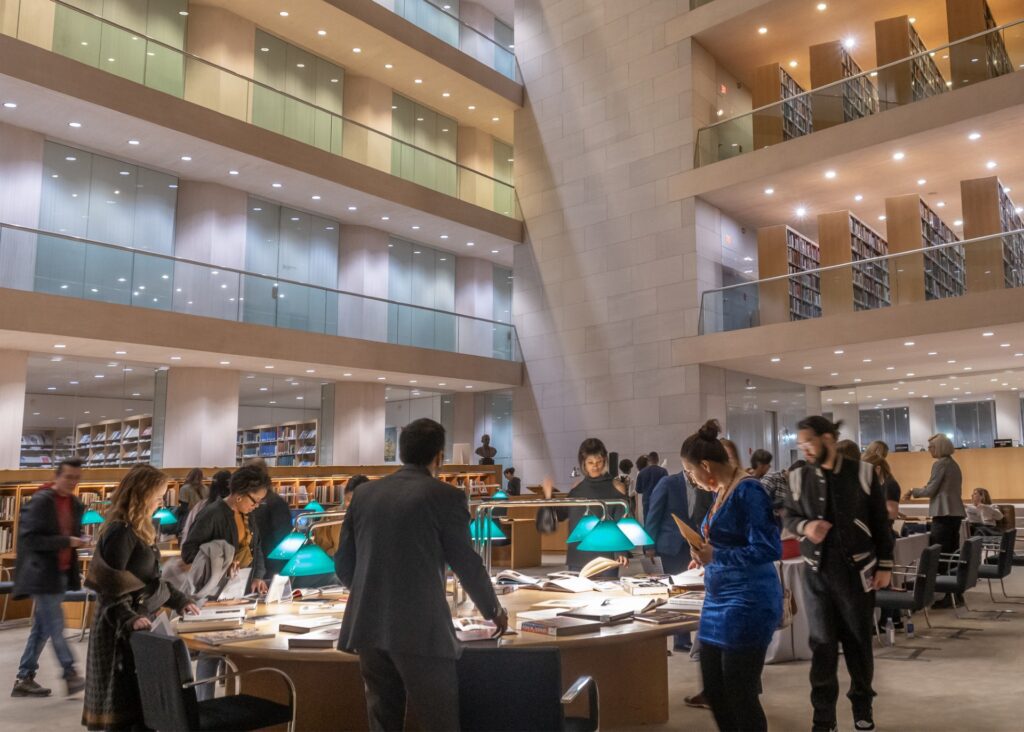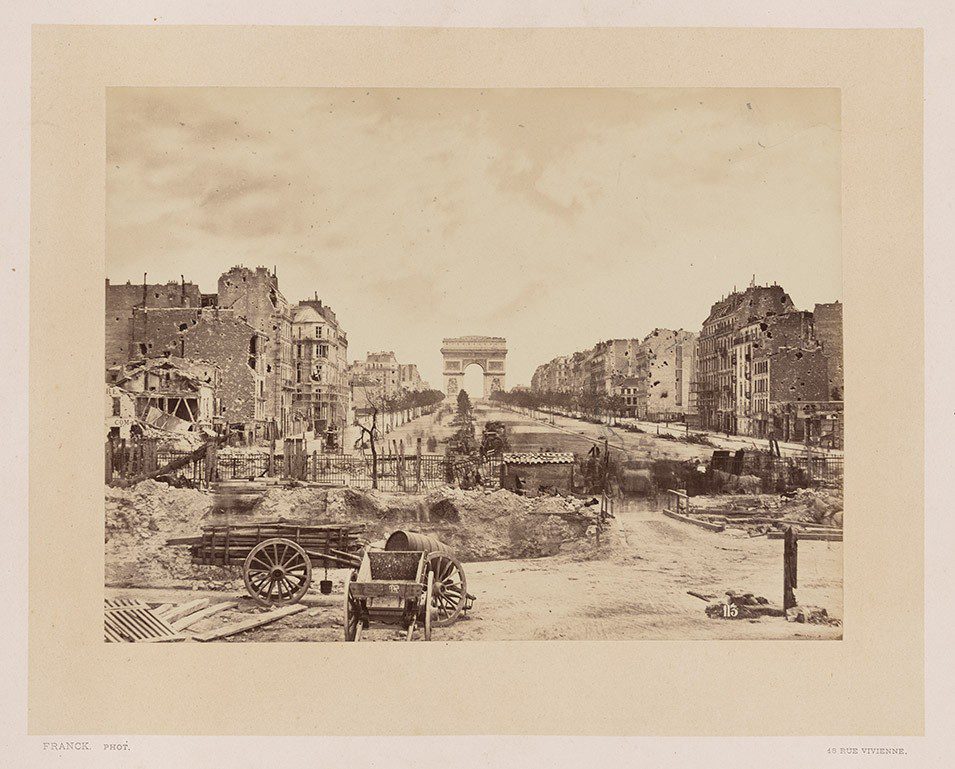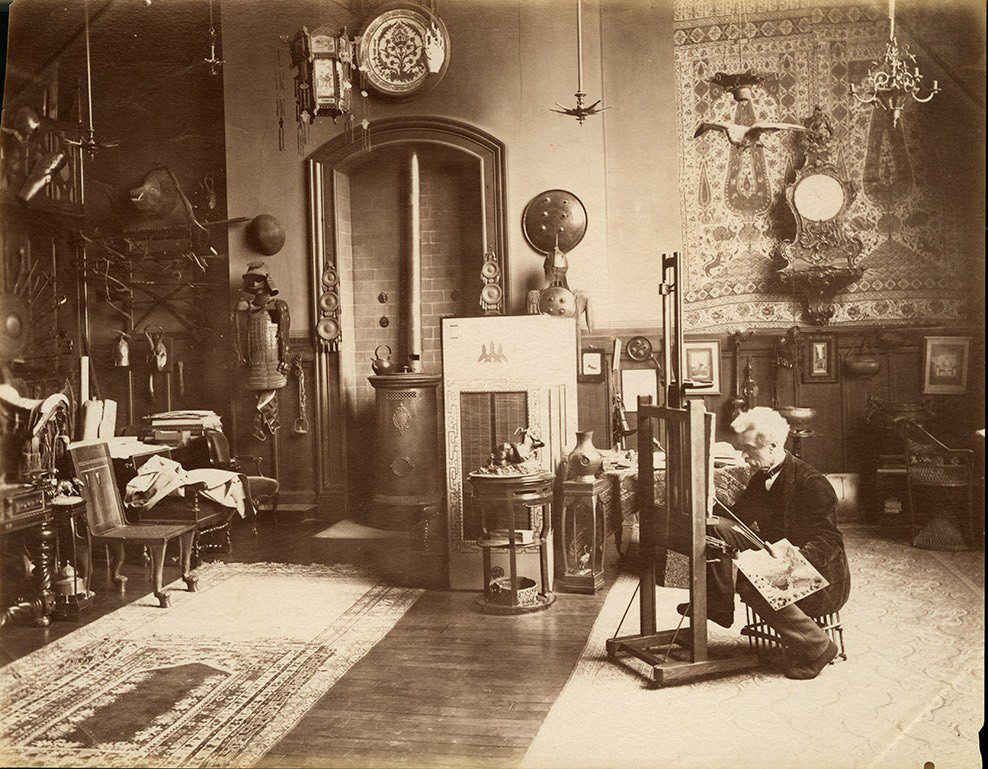The National Gallery of Art, From a Different Angle
By • August 22, 2024 One Comment 1592

The Champs-Élysées is in ruins. Though the Arc de Triomphe is intact in the distance, on each side of Paris’s grand avenue the walls of elegant apartment buildings are exposed and punctured. Two carts stand amid rubble in the desolate scene’s foreground.
Depicting the aftermath of the Franco-Prussian War and the Paris Commune, “Paris-incendié (Paris Burned)” — an 1871 photograph by Franck, the professional name of François Gobinet de Villechole — is part of “Life in the Impressionists’ Paris,” on view in the National Gallery of Art Library from Sept. 4 through Jan. 17.
The display of some 40 photographs and prints was created to provide context for the major exhibition “Paris 1874: The Impressionist Moment,” opening four days later across Fourth Street NW in the NGA’s West Building.
An end-grain woodblock engraving by Louis Paul Pierre Dumont shows the vernissage — an exhibition’s opening day, when the paintings were varnished — of the 1874 Salon in Paris’s Palace of Industry, built for the 1855 Exposition Universelle. Holding her jacket and parasol, a woman in a long, buttoned-up dress peers through handheld spectacles at a work to our left (not shown), as if we, the viewers, are there in the gallery with her. Behind other visitors in formal dress, some seated, two men on ladders brush varnish on the framed artworks, hung tightly spaced (“salon style”).
The annual Salons were the official French art exhibitions, but on April 15 of that year, two weeks before the vernissage shown in the engraving, a smaller, less popular show opened for a month at 35 Boulevard des Capucines. The well-lighted, second-floor space had been the studio of photographer Félix Nadar, who, having relocated, let a group of painters, most rejected by the Salon, use it gratis. Though a one-franc admission was charged, the show was not a financial success. Worse, the art was mocked as “impressionism.”
Of the 31 artists represented in this first Impressionist exhibition, only two were women: the Comtesse de Luchaire and Berthe Morisot. Morisot was among the handful of artists whose names most of us would recognize today: Cézanne, Degas, Monet, Pissarro, Renoir, Sisley and perhaps Boudin and Guillaumin. “Paris 1874,” the National Gallery’s West Building show, previously at the Musée d’Orsay, marks the 150th anniversary of Impressionism’s public premiere, featuring works from that first of eight Impressionist exhibitions (the last in 1886), as well as from the 1874 Salon.
Two other photographs in the library’s display: an 1899 portrait of Monet by Nadar’s son Paul in which the painter could be mistaken for a statesman, facing right with short-cropped hair and a beard less bushy than usual; and Edmond Bénard’s image of leading academic painter, sculptor and teacher Jean-Léon Gérôme in his large, high-ceilinged studio, c. 1884-94. Holding a rectangular palette, the white-haired artist crouches at his easel on a low stool; suits of armor — one European, one Japanese — flank a cast-iron stove and (though colorless in the photograph) patterned carpets enliven the floor and back wall.
Curated by architectural historian Elisabeth Narkin, an image specialist at the library, and art historian Ellen Prokop of the NGA’s office of collections, exhibitions and programs, “Life in the Impressionists’ Paris” suggests how the new Third Republic was not only rebounding from defeat and insurrection but energized by technological innovations in image-making. No longer on metal, photographs were printed on paper coated in albumen (egg white), perfect for cartes de visite (visiting cards). Also popular: stereographs — double-images viewed in a stereoscope for a 3D effect — and illustrated postcards, which took off with views of the Eiffel Tower, constructed for the 1889 Exposition Universelle.
Thought the National Gallery is open daily from 10 a.m. to 5 p.m., access to “Life in the Impressionists’ Paris” is generally available only during regular library hours, Monday through Friday from 11 a.m. to 4:30 p.m. Upcoming exceptions are the NGA’s First Saturday program on Sept. 7 and the monthly National Gallery Night on Sept. 12, “A Night in Paris.”
Registration for National Gallery Nights, which run from 6 to 9 p.m., is free but limited. A lottery opens at 10 a.m. on Monday of the week before and closes at noon on Thursday of the week before. Walk-up passes are distributed at the East Building entrance on a first-come, first-served basis starting at 5:30 p.m. on the day of the event.

“Paris-incendié,” 1871. Franck. Courtesy NGA Library.
Relatively few of the National Gallery’s three or four million annual visitors are aware of the adjacent existence of one of the world’s great art libraries. Even fewer know that they are permitted to enter, and do so.
The library receives about 1,100 “external visitors” per year. About half are scholars, a quarter are students and the remaining quarter are miscellaneous researchers and members of the general public — perhaps to see an “In the Library” exhibition. All those other NGA visitors are missing one of East Building (and, later, Louvre Pyramid) architect I. M. Pei’s most stunning spaces.
Constructed on a wedge-shaped site between Pennsylvania Avenue and the National Mall, the East Building — which opened in 1978, the gift of Paul Mellon, Ailsa Mellon Bruce and the Andrew W. Mellon Foundation — was conceived by Pei (who died in 2019, aged 102) as two side-by-side triangles: an isosceles triangle and a smaller acute right triangle.
The National Gallery’s study center occupies the smaller triangle, with its famous 19-degree “knife edge.” At its heart is the library, originally established in 1941 in what is now the West Building, with an angular atrium framed by four levels of stacks (also on those floors: NGA offices with Capitol views). The ground floor is the main reading room and exhibition space.

“Jean-Léon Gérôme in his studio,” c. 1884-94. Edmond
Bénard. Courtesy NGA Library.
Since there are more than 500,000 books, periodicals and digital-media items in the collection, the three floors underground were well worth their excavation. Other stats: 3,000-plus scholarly journals, 12,000-plus rare books and 16 million-plus images. The library’s online catalog is at library.nga.gov.
The NGA’s exhibition catalogs and various publications by CASVA (Center for Advanced Study in the Visual Arts, founded in 1979) visiting professors and fellows, including the dissertations of predoctoral fellows, are researched in the library. A recent example of the many books by outside scholars incorporating research in the library’s collection: “Venice: The Remarkable History of the Lagoon City” by Dennis Romano, published in January by Oxford University Press.
In June, the National Gallery welcomed a new chief librarian. Heather Slania is a graduate of Northwestern University — where she double-majored in art theory and practice and performance studies — and the University of Maryland, College Park, where she earned her master’s in library and information science. Earlier, she was in charge of the libraries of the National Museum of Women in the Arts and Baltimore’s Maryland Institute College of Art.
Slania also has a Georgetown connection. “My journey as an art librarian began at Georgetown University, where I built on my background in special collections and fine art,” she said. The NGA role is her first federal government position.


Another brilliant and insightful Selden review. Bravo!